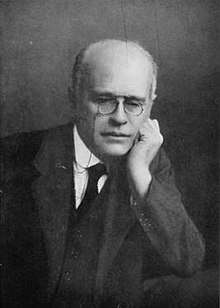C. Ainsworth Mitchell
Charles Ainsworth Mitchell FRIC FCS (20 November 1867 – 5 January 1948)[1] was a British chemist and forensic scientist who made a special study of the microscopic and chemical study of handwriting.[2] He was a Fellow of the Royal Institute of Chemistry and the Chemical Society, and member of the Society of Public Analysts[2][3] He was editor of The Analyst for 25 years, president of the Medico-Legal Society (1935–1937), and vice president of the Society of Chemistry (1937–1940).[1]
C. Ainsworth Mitchell | |
|---|---|
 | |
| Born | 20 November 1867 |
| Died | 5 January 1948 (aged 80) |
Life
Mitchell was born 20 November 1867 in Thetford, England, the third son of Dr. T. H. Mitchell. He was educated at King William's College, and Exeter College, Oxford, graduating in 1889. In 1899 he married Edith Boyle Keely.[1][4]
Career
Chemist
As a chemist and a scientist, Mitchell's work covered a wide range of topics. He became a fellow of the Royal Institute of Chemistry in 1897 and of the Chemical Society in 1916.[1][4] In 1907 he advocated using a pinhole camera to photograph the sun in an article in Knowledge and Scientific News, a method which he notes was known as early as 1615 but seemed to have been forgotten.[5][6] In 1911, he advocated the switch from lead to copper pipes for drinking water. His reasoning was that copper would better be able to alert the drinker to an excess of poisonous sulphates in the water.[7] In 1920, he became editor of The Analyst, a journal of the Chemical Society, and under 25 years of his editorship the journal expanded in scope and increased in reputation.[8]
Criminologist
In 1911 he was head of the inspection bureau of Scotland Yard.[9] He frequently served as an expert witness. In 1915, he gave testimony about the invisible ink used in the case of German spy, Anton Kuepferle.[3]
In 1925 he analyzed documents and seals of Mary, Queen of Scots and claimed to show that Mary was innocent of conspiracy to assassinate Queen Elizabeth I of England. He said that William Maitland, Mary's secretary, forged Mary's hand in the documents which led to Mary's execution.[10] In 1929, he was an advocate of the use of fingerprints to determine identity, a method which he traced to Sir William Herschell in 1853, who saw the method used in to document an individuals identity in India, where he was a commissioner.[11] He showed that monkeys may be identified by fingerprints and that the same could be done with the markings on a cow's nose.[12]
He was hired by Ruth White to analyze the Will and Testament of `Abdu'l-Bahá. White opposed parts of the will that suggested the establishment of a hierarchy in the Bahá'í Faith. His report concluded in agreement with White, that the document was a forgery.[13] White placed Mitchell's signed report on the writing shown on the photographs of the document with the U.S. Library of Congress in 1930.[14]
Bibliography
Mitchell's works include:
- Inks: their composition and manufacture (1904)[15]
- Science and the Criminal (1911).[16][17]
- Edible Oils & Fats (1918)[18]
References
- Cox, H. E. (1948). "Obituary: Charles Ainsworth Mitchell 1867–1948". The Analyst. 73 (863): 55–57. Bibcode:1948Ana....73...55C. doi:10.1039/AN948730055B.
- The Police Courts, The Times (London, England) November 29, 1907, page 6, accessed October 24, 2016 at https://www.newspapers.com/clip/7159501/the_police_courts_the_times_london/
- Alleged Spy on Trial, The Times (London, England) May 19, 1915, page 22, column 4 accessed October 24, 2016 at https://www.newspapers.com/clip/7159685/alleged_spy_on_trial_the_times/
- "C. A. Mitchell, M.A., D.Sc". British Medical Journal. 1 (4541): 128–129. January 17, 1948. doi:10.1136/bmj.1.4541.128. JSTOR 25362064.
- Pinhole Pictures, Peninsula Enterprise (Accomac, Virginia) January 4, 1908, page 4, accessed October 24, 2016 at https://www.newspapers.com/clip/7159530/pinhole_pictures_peninsula_enterprise/
- Wall, E. J. Pinhole Photography of the Sun, The Photographic News: A Weekly Record of the Progress of Photography, Volume 51, Cassell, Petter and Galpin, 1907 accessed as page 399 of https://books.google.com/books?id=3Ts8AQAAMAAJ&pg=PA399 on October 24, 2016
- Copper Water Pipes, Duluth News-Tribune (Duluth, Minnesota), Saturday, October 7, 1911, Volume: 43 Issue: 155 Page: 13
- "Dr. C. Ainsworth Mitchell and The Analyst". Nature. 156 (3963): 443–444. 13 October 1945. Bibcode:1945Natur.156T.443.. doi:10.1038/156443d0.
- Expert Testimony, The Rock Island Daily Union (Rock Island, Illinois) October 16, 1911, page 6, accessed October 24, 2016 at https://www.newspapers.com/clip/7159618/expert_testimony_the_rock_island_daily/
- Recent Tests Show Mary, Queen of Scots, Innocent, Brown County Democrat (Nashville, Indiana) June 23, 1925, page 4, accessed October 24, 2016 at https://www.newspapers.com/clip/7159730//
- The Use of Finger Prints, The Age (Melbourne, Victoria, Australia, December 14, 1929, page 5, accessed October 24, 2016 at https://www.newspapers.com/clip/7159796/the_use_of_finger_prints_the_age/
- Monkey's identified, Lincoln Evening Journal (Lincoln, Nebraska), November 22, 1929, page 13, accessed October 24, 2016 at https://www.newspapers.com/clip/7159753/monkeys_identified_lincoln_evening/
- Momen, Moojan. Studies in Honor of the Late Hasan M. Balyuzi. Vol. 5. Kalimát Press, 1988. p273-274
- Bahais. "Dr. C. (Charles) Ainsworth Mitchell, Report on the Writing Shown on the Photographs of the Alleged Will of Abdu'l-Baha, Library of Congress, 1930, Ruth White".
- Mitchell, Charles Ainsworth, and Thomas Cradock Hepworth. Inks: their composition and manufacture. C. Griffin & company, limited, 1904.
- Mitchell, C. Ainsworth (31 December 2013). "Science and the Criminal" – via Project Gutenberg.
- "Tell-Tale Inks - TESTS IN CRIME AND FORGERY - Albany Advertiser (WA : 1897 - 1950) - 29 Apr 1930".
- Michell, Charles Ainsworth. Edible Oils & Fats, Longmans, Green 1918